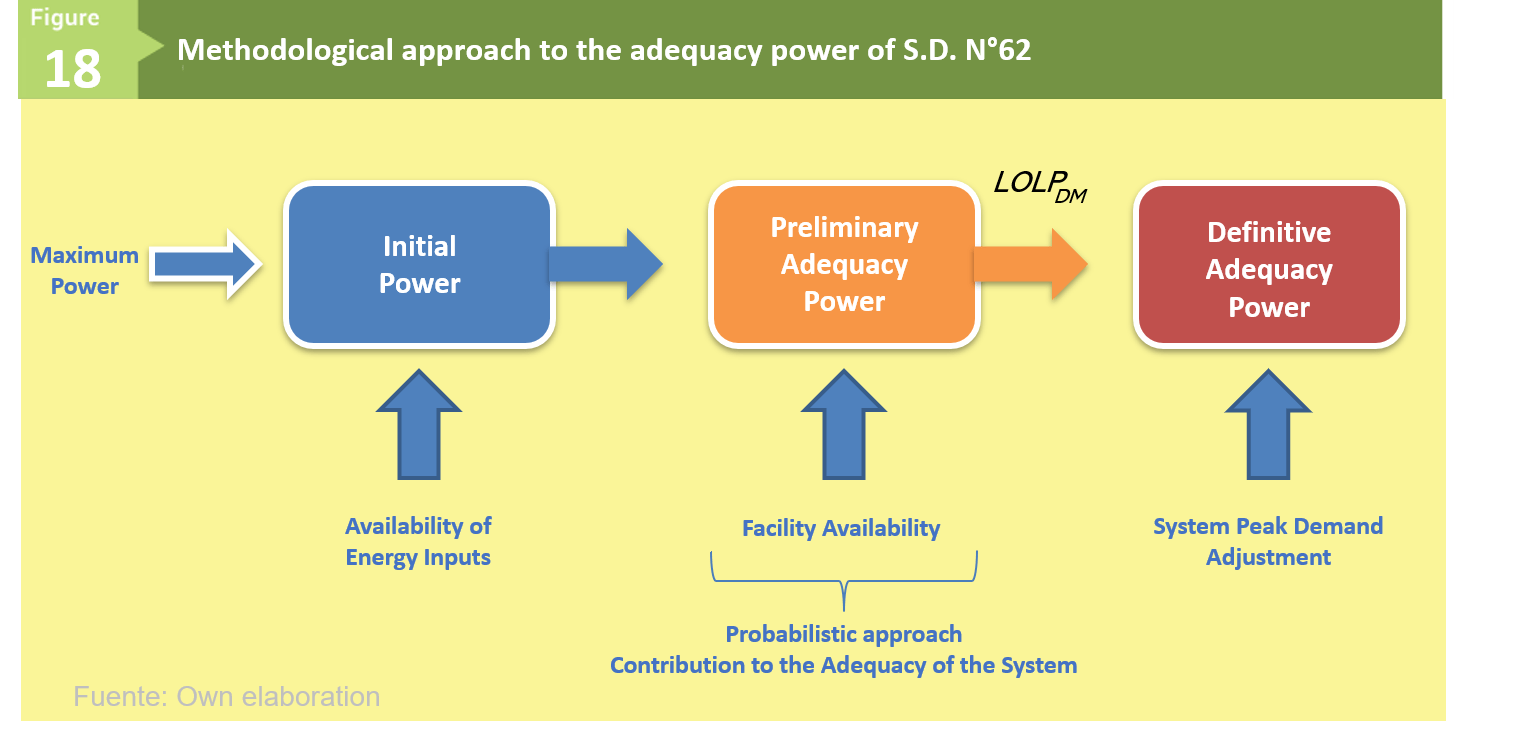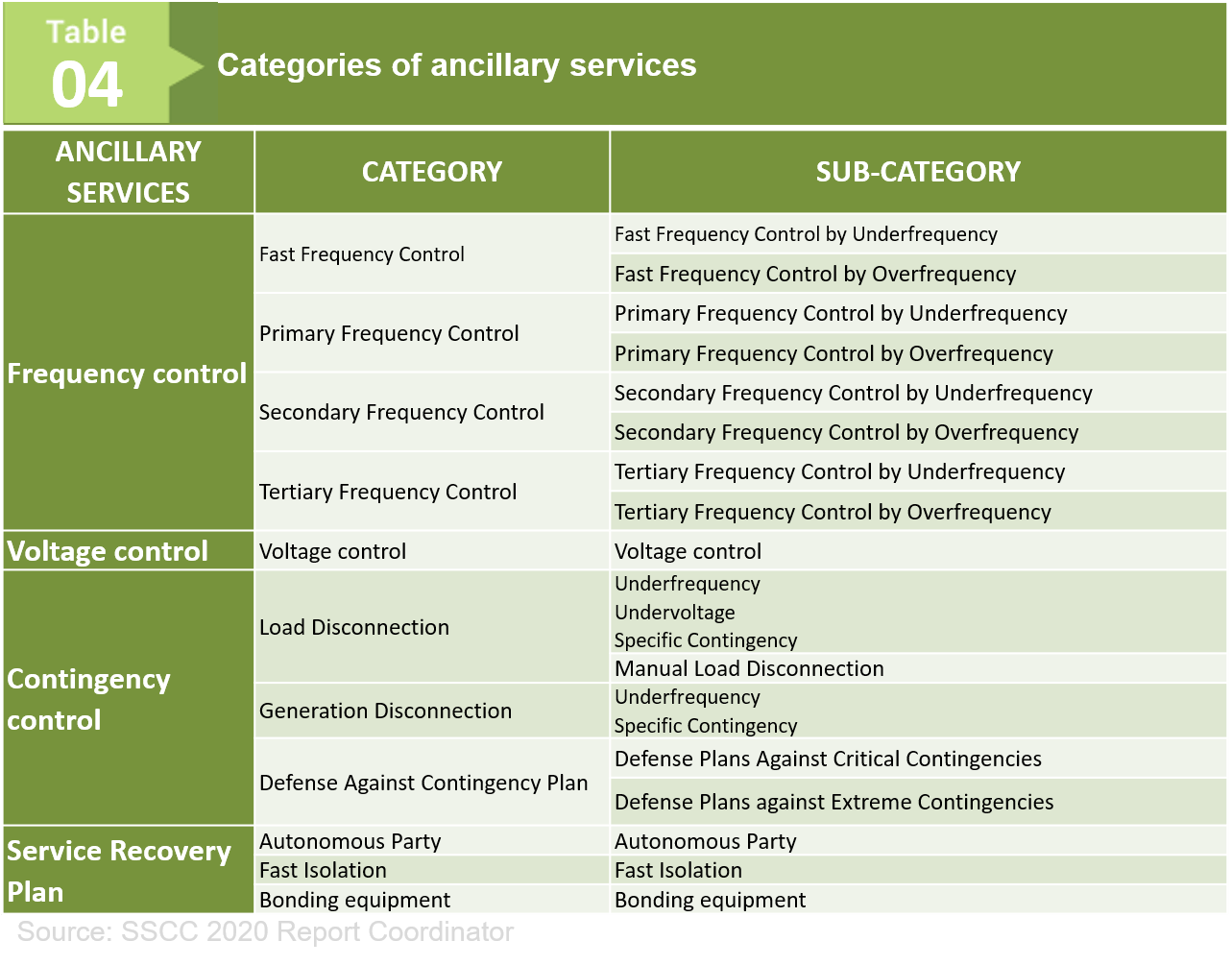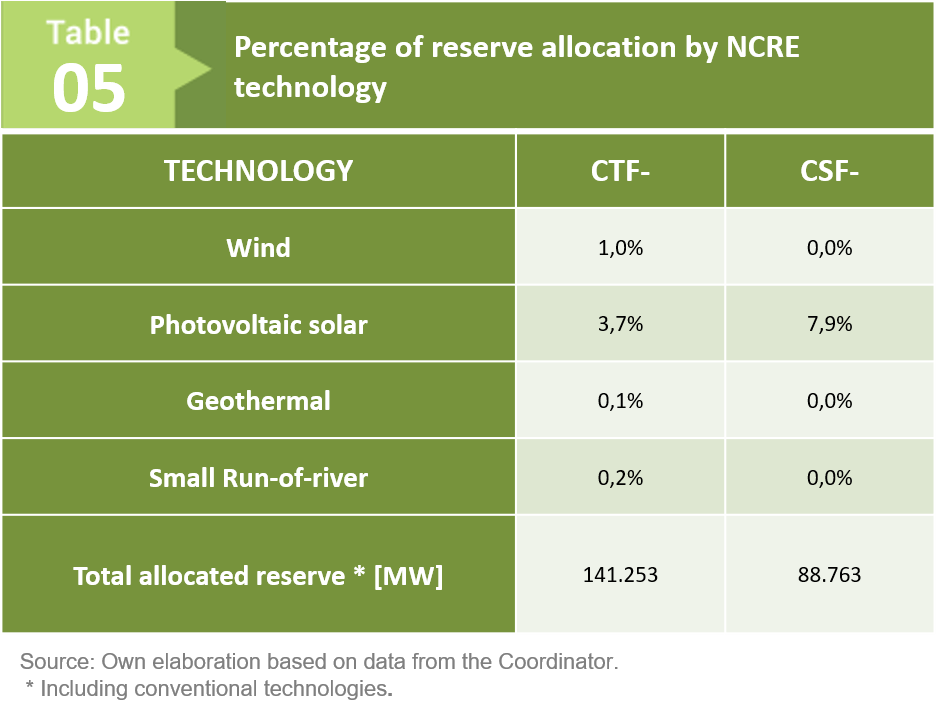3.5. Adequacy and safety of the electric system
The legislation distinguishes the concepts of adequacy and safety of the electric system; deriving the latter to the implementation of ancillary services (SSCC). These concepts are explicitly defined in the current legislation [23]
- Adequacy: attribute of an electric system whose facilities are adequate to supply its demand.
- Service security: responsiveness of an electric system, or part of it, to support contingencies and minimize consumption loss through backups and ancillary services.
- Ancillary Services (SSCC): benefits that allow the coordination of the operation of the system. At least ancillary services include frequency control, voltage control and service recovery plan, both under normal operating conditions and before contingencies. These services will be provided by means of the technical resources required in the operation of the electric system, such as the capacity of active power generation, capacity of injection or absorption of reactive power or connected power of users, among others, and by the infrastructure associated to the provision of the technical resource.
In other words, adequacy corresponds to the ability of the system to supply the entire electrical demand and the energy requirements of the consumers at all times, considering programmed outputs of components and outputs that are not programmed but reasonably expected. Safety, on the other hand, is understood as the ability of the electrical system to withstand surprising disturbances such as electric short-circuits or unexpected loss of system components or disconnection operations.
The adequacy attribute recognizes through capacity payment, this payment focuses on the recognition, in terms of power, of the contribution of the different generators to the tip demand of the system and is valued in terms of the investment costs of the generation unit used for the system’s peak hours. In the security attribute, its payment should be through the recognition of Ancillary Services.
Until January 2016 in the Chilean electric sector, the attributes of safety and adequacy, were grouped under the concept of firm power. This is despite the fact that the LGSE differentiates both concepts since the regulation to define the recognition of the sufficiency attribute (S.D. N°62 of 2006 [24]) has been published since 2006. However, it was necessary to wait until ancillary services were defined and implemented to achieve to separate both concepts in practice. This happened in January 2016, with the publication of the Technical Standard of Power Transfer between Generating Companies.
The S.D. N°62 of 2006 defines the guidelines for determining power transfers between generating companies. Those that will be determined from the generation capacity compatible with the adequacy and the existing peak demand commitments. In such a way that each owner of generation means must be in a position to satisfy their own commitments for peak demand, considering their adequacy power and that acquired from other generating companies. These transfers will be valued at the power’s short-term node price in the corresponding bar.
Each generating unit will be assigned a definitive adequacy power based on:
- the uncertainty associated with the availability of the generation input,
- forced unavailability of the unit, and
- the supply of power from the generating park.
The general scheme of the adequacy power calculation procedure established by the S.D. N°62 is illustrated in Figure 18. The stages and concepts used in the adequacy power calculation process for each type of plant are described in greater in Annex 3.
On the other hand, the S.D. N°42 of 2020 introduces the State of Strategic Reserve for generating units that begin the process of phase-out from the SEN, in the context of the decarbonization program of the energy matrix. These units will only be summoned to the dispatch by the Coordinator if he foresees significant generation deficits or conditions affecting the security of the system. Once convened, the unit must be in a position to inject energy within a period of no more than 60 days.
Units in a Strategic Reserve Status will be remunerated by concept of sufficiency. For the calculation of the contribution to the sufficiency of the electrical system, an equivaent power no greater than 60% of the maximum power of the corresponding unit will be recognized.
The Ministry of Energy in conjunction with the CNE are developing a participatory work associated with the development of a new Power Regulation. For this purpose, working groups have been formed with different actors of the national electricity sector in order to discuss, analyze and propose the best alternatives for adequate regulation in matters associated with the treatment of power in the National Electric System.
Among these alternatives, the application of probabilistic methodologies (such as Effective Load Carrying Capability, ELCC) to determine the contribution to the sufficiency of the system by the units stands out. In addition, it is proposed that the value of the power injection decreases depending on the over-installation of generation of the electrical system and the inefficiency (variable cost) of the unit that performs said injection. Among other improvements to the process of determining power transfers.

Ancillary services are those benefits that make it possible to preserve the security of the service in the electrical system and guarantee the most economical and quality operation for all the SEN facilities. Through these services, the security provided by the facilities to the system is recognized and remunerated.
The CNE is the body in charge of defining, after a report from the Coordinator, the ancillary services and their categories. Ancillary services are frequency control, voltage control, contingency control and the service recovery plan.
Ancillary services are organized into categories and subcategories, depending on the contribution they make to compliance with the standards defined in the Technical Standard for Safety and Service Quality.
 For its part, the Coordinator must prepare an Ancillary Services Report each year indicating the services required by the electrical system, the technical resources necessary for the provision of this services, the infrastructure that must be installed for its provision and its useful life. In addition, the report must indicate for each of the services required the mechanism through which its provision will be materialized, which must be appropriate to the condition of competition in the offer of this service, always selecting auction and bidding mechanisms when there is one competition, and direct instruction mechanisms when this is not the case.
For its part, the Coordinator must prepare an Ancillary Services Report each year indicating the services required by the electrical system, the technical resources necessary for the provision of this services, the infrastructure that must be installed for its provision and its useful life. In addition, the report must indicate for each of the services required the mechanism through which its provision will be materialized, which must be appropriate to the condition of competition in the offer of this service, always selecting auction and bidding mechanisms when there is one competition, and direct instruction mechanisms when this is not the case.
For this, Law 20,936 of July 2016 authorized the Coordinator to carry out bids or auctions when the requirement is very short-term. Exceptionally and only when market conditions are not competitive or tenders or auctions are declared void, the provision could be directly instructed. In other words, a mixed regime of free market and provision via requirement was proposed.
Subsequently, in March 2019, a new regulation of ancillary services was approved (S.D. N°113 of 2017). This regulation establishes the way in which the services required by the SEN and its provision and installation mechanisms will be defined. It also establishes how the auctions, tenders and direct instruction of said services will be carried out. In addition, it defines the general conditions for the completion of the Ancillary Services Report and Cost Study.
The valuation of the ancillary services that are auctioned or tendered will correspond to the value awarded in the respective tender or auction. In the event that an auction is declared void, the service will be remunerated at the maximum price of said process. In relation to the services that must be provided or installed directly (without a bidding process), these will be valued through a Cost Study.
Exempt Resolution No. 442 of November 2020 establishes the components that must be added to the value offered in the frequency control auctions, to make up the price awarded in them. This awarded value will be made up of the sum of the value offered and awarded in the auction, opportunity costs for not selling energy destined for reserve, over costs for operating at a marginal cost lower than the variable cost of the unit and inefficiency costs for operating at a suboptimal point.
In other words, frequency control auctions present an ex-post payment scheme. Which allows reducing economic risks that affect potential service providers. Therefore, the value offered in the auction should only assume wear and tear costs. However, after Resolution No. 442 became effective, the remuneration associated with the value offered represents an average 1.88% of the total payment of ancillary services per auction, between December 2020 and April 2021. Therefore, the payment of cost overruns, opportunity costs, infrastructure and remuneration at the maximum price for direct instruction represents 98% of the total payments by ancillary services.
To determine the bid awarded in the frequency control auctions, the Coordinator must carry out the joint energy and reserve co-optimization process one day in advance, which must guarantee the efficient and safe operation of the SEN.
The assignment of the facility providing an ancillary service is technologically neutral. This allows new players to enter the ancillary services market without discrimination. In this way, ERNC technologies have provided ancillary services in the categories of frequency control, voltage control, automatic generation disconnection scheme and fast isolation, for example, in August 2020, NCREs awarded services for underfrequency.
 The payment of an ancillary service depends on whether the provision was through new infrastructure or existing technical resource. In the latter case, it will be the generating companies in proportion to their physical withdrawals who will have to pay for the service. On the contrary, if it is necessary to install new infrastructure in the system, it will be the end users who will have to contribute to the payment through the charge of ancillary services.
The payment of an ancillary service depends on whether the provision was through new infrastructure or existing technical resource. In the latter case, it will be the generating companies in proportion to their physical withdrawals who will have to pay for the service. On the contrary, if it is necessary to install new infrastructure in the system, it will be the end users who will have to contribute to the payment through the charge of ancillary services.










